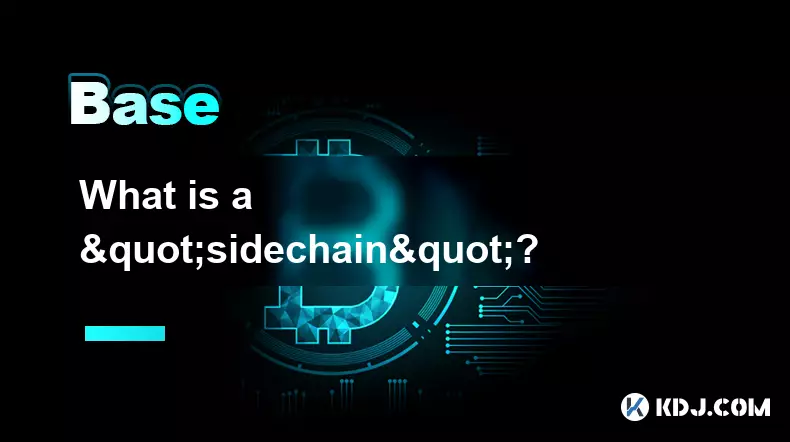-
 bitcoin
bitcoin $114684.631706 USD
-0.87% -
 ethereum
ethereum $4228.677447 USD
1.58% -
 bnb
bnb $1294.880693 USD
-1.16% -
 tether
tether $1.000819 USD
-0.02% -
 xrp
xrp $2.605138 USD
2.79% -
 solana
solana $209.908690 USD
5.89% -
 usd-coin
usd-coin $0.999903 USD
-0.03% -
 dogecoin
dogecoin $0.213423 USD
2.93% -
 tron
tron $0.322721 USD
-0.10% -
 cardano
cardano $0.727247 USD
3.66% -
 hyperliquid
hyperliquid $42.339456 USD
6.05% -
 chainlink
chainlink $19.910811 USD
5.16% -
 ethena-usde
ethena-usde $1.000557 USD
0.00% -
 stellar
stellar $0.349734 USD
2.69% -
 bitcoin-cash
bitcoin-cash $543.848687 USD
-0.21%
What is a "sidechain"?
Sidechains boost scalability and innovation by enabling secure, independent blockchains linked to a mainchain via two-way pegs.
Oct 13, 2025 at 02:36 pm

Understanding the Concept of Sidechains
1. A sidechain is a blockchain that operates independently but is connected to another blockchain, known as the mainchain, through a two-way peg mechanism. This allows digital assets to be securely transferred between the mainchain and the sidechain. The primary purpose of a sidechain is to extend the functionality of the mainchain without altering its original protocol.
2. The transfer process involves locking tokens on the mainchain and minting equivalent tokens on the sidechain. When users wish to return their assets, the sidechain tokens are burned, and the original tokens are unlocked on the mainchain. This ensures that the total supply remains consistent across both chains and prevents double-spending.
3. Sidechains enable experimentation with new features such as faster transaction speeds, alternative consensus mechanisms, or enhanced privacy tools, all while maintaining the security and stability of the mainchain. Developers can test upgrades or entirely new protocols in a live environment without risking the integrity of the primary network.
4. Unlike layer-2 solutions that rely on the mainchain for finality, sidechains function as standalone blockchains with their own validators and consensus rules. This independence gives them greater flexibility but also means they must establish their own security model, which may not be as robust as that of the mainchain.
5. Examples include Liquid Network, a Bitcoin sidechain designed for faster exchange settlements, and Polygon PoS, which serves as a sidechain for Ethereum to reduce congestion and lower transaction fees. These implementations demonstrate how sidechains can address scalability and performance limitations inherent in major blockchains.
Benefits of Utilizing Sidechains
1. One of the most significant advantages is scalability. By offloading transactions from the mainchain, sidechains help reduce network congestion and improve overall throughput. This results in quicker confirmations and lower fees, making blockchain applications more accessible to a broader user base.
2. Developers gain the freedom to implement custom logic, smart contract standards, or governance models tailored to specific use cases. This level of customization supports innovation in areas like decentralized finance (DeFi), gaming, and non-fungible tokens (NFTs).
3. Because sidechains operate in parallel to the mainchain, they do not require consensus changes to the core protocol. This avoids contentious hard forks and allows upgrades to be deployed more rapidly and with less coordination overhead.
4. Users benefit from improved user experience due to faster processing times and reduced costs. Enterprises and institutions can leverage private or semi-private sidechains for internal operations while still maintaining interoperability with public networks when needed.
5. The modular design promotes ecosystem diversity. Different sidechains can specialize in distinct functions—some focusing on privacy, others on high-frequency trading or cross-chain asset management—creating a layered, interconnected blockchain landscape.
Risks and Limitations of Sidechains
1. Security is a major concern since sidechains are responsible for their own validation. If a sidechain has fewer nodes or weaker consensus mechanisms, it becomes more vulnerable to attacks such as 51% takeovers or validator collusion.
2. The two-way peg mechanism introduces complexity and potential points of failure. If the bridge between the mainchain and sidechain is compromised, funds could be stolen or permanently locked, leading to significant financial losses.
3. Trust assumptions increase when third-party validators or federated models manage the sidechain. Users must trust these entities to act honestly, which contrasts with the trustless nature of decentralized mainchains like Bitcoin or Ethereum.
4. Interoperability challenges arise when multiple sidechains exist within an ecosystem. Ensuring seamless communication and asset transfers between different sidechains requires standardized protocols and reliable infrastructure.
5. Regulatory scrutiny may intensify as sidechains facilitate cross-border transactions and alternative financial systems. Authorities might view independent chains with autonomous governance as potential avenues for circumventing compliance requirements.
Frequently Asked Questions
How does a sidechain differ from a layer-2 solution? A sidechain is an independent blockchain with its own consensus mechanism, whereas a layer-2 solution operates on top of the mainchain and relies on it for security. Layer-2s like Lightning Network or rollups derive trust from the mainchain, while sidechains must secure themselves.
Can any blockchain create a sidechain? Technically, yes, provided the mainchain supports interoperability features such as hash time-locked contracts or federation-based bridges. However, implementing a secure and functional sidechain requires substantial technical expertise and infrastructure investment.
Are sidechain transactions reversible? No, like transactions on most blockchains, sidechain transactions are irreversible once confirmed under their consensus rules. Users should exercise caution when transferring assets, especially across bridges where mistakes can lead to permanent loss.
Do sidechains require their own native token? Many sidechains issue a native token to incentivize validators and pay for gas fees. Some use wrapped versions of the mainchain’s token, while others introduce new tokens to fund development and governance within the sidechain ecosystem.
Disclaimer:info@kdj.com
The information provided is not trading advice. kdj.com does not assume any responsibility for any investments made based on the information provided in this article. Cryptocurrencies are highly volatile and it is highly recommended that you invest with caution after thorough research!
If you believe that the content used on this website infringes your copyright, please contact us immediately (info@kdj.com) and we will delete it promptly.
- XRP Price Prediction: Weekend Rollercoaster or Rally?
- 2025-10-12 08:45:16
- Bittensor (TAO): Super Bullish Signals Point to Potential 2x Rally
- 2025-10-11 10:25:12
- Silver Price Correction: Navigating the Dip & Identifying Key SEO Keywords
- 2025-10-11 10:25:12
- Decoding Crypto Trends: Bittensor's Bull Run, Cardano's Dip, and LivLive's Presale Buzz in 'Uptober 2025'
- 2025-10-12 08:45:16
- MoonBull: The Crypto Meme Coin Promising 1000x Gains?
- 2025-10-11 10:30:01
- Crypto Payroll Revolution: Stablecoins, Altcoins, and the Future of Salary Payments
- 2025-10-11 10:30:01
Related knowledge

What does it mean for code to be "open source" in crypto?
Oct 12,2025 at 01:54pm
Understanding Open Source in the Cryptocurrency Ecosystem1. In the context of cryptocurrency, open source refers to software whose code is publicly ac...

What is the purpose of a "testnet"?
Oct 12,2025 at 09:01am
Understanding the Role of Testnets in Blockchain Development1. A testnet serves as a parallel version of a blockchain network, designed specifically f...

How to avoid phishing scams in crypto?
Oct 13,2025 at 06:18pm
Understanding Common Crypto Phishing Tactics1. Cybercriminals frequently use fake websites that mirror legitimate crypto exchanges or wallet platforms...

What is the difference between single-collateral and multi-collateral Dai?
Oct 12,2025 at 05:18pm
Understanding Single-Collateral Dai1. Single-Collateral Dai (SCD) was the original version of the Dai stablecoin launched by MakerDAO in 2017. It allo...

What is a "sidechain"?
Oct 13,2025 at 02:36pm
Understanding the Concept of Sidechains1. A sidechain is a blockchain that operates independently but is connected to another blockchain, known as the...

What is "EIP-1559" and how did it change Ethereum?
Oct 12,2025 at 03:00am
Understanding EIP-1559 and Its Core Mechanism1. EIP-1559 is a protocol upgrade introduced to the Ethereum blockchain as part of the London hard fork i...

What does it mean for code to be "open source" in crypto?
Oct 12,2025 at 01:54pm
Understanding Open Source in the Cryptocurrency Ecosystem1. In the context of cryptocurrency, open source refers to software whose code is publicly ac...

What is the purpose of a "testnet"?
Oct 12,2025 at 09:01am
Understanding the Role of Testnets in Blockchain Development1. A testnet serves as a parallel version of a blockchain network, designed specifically f...

How to avoid phishing scams in crypto?
Oct 13,2025 at 06:18pm
Understanding Common Crypto Phishing Tactics1. Cybercriminals frequently use fake websites that mirror legitimate crypto exchanges or wallet platforms...

What is the difference between single-collateral and multi-collateral Dai?
Oct 12,2025 at 05:18pm
Understanding Single-Collateral Dai1. Single-Collateral Dai (SCD) was the original version of the Dai stablecoin launched by MakerDAO in 2017. It allo...

What is a "sidechain"?
Oct 13,2025 at 02:36pm
Understanding the Concept of Sidechains1. A sidechain is a blockchain that operates independently but is connected to another blockchain, known as the...

What is "EIP-1559" and how did it change Ethereum?
Oct 12,2025 at 03:00am
Understanding EIP-1559 and Its Core Mechanism1. EIP-1559 is a protocol upgrade introduced to the Ethereum blockchain as part of the London hard fork i...
See all articles










































































